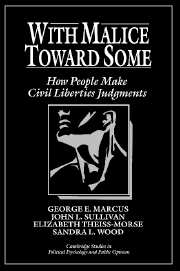Book contents
- Frontmatter
- Contents
- List of Figures and Tables
- Preface: Political Tolerance and Democratic Life
- PART I Theoretical Background and Overview
- PART II Contemporary Information and Political Tolerance Judgments
- PART III Refining the Model – The Role of Antecedent Considerations as Individual Differences
- 5 Threat and Political Tolerance
- 6 Democratic Values as Standing Decisions and Contemporary Information
- 7 Source Credibility, Political Knowledge, and Malice in Making Tolerance Judgments – The Texas Experiment
- 8 Individual Differences: The Influence of Personality
- PART IV Implications and Conclusions
- Appendix A: Hypothetical Group Scenarios and Manipulations
- Appendix B: Methodological Approaches and Scales
- Notes
- References
- Index
5 - Threat and Political Tolerance
Published online by Cambridge University Press: 05 August 2012
- Frontmatter
- Contents
- List of Figures and Tables
- Preface: Political Tolerance and Democratic Life
- PART I Theoretical Background and Overview
- PART II Contemporary Information and Political Tolerance Judgments
- PART III Refining the Model – The Role of Antecedent Considerations as Individual Differences
- 5 Threat and Political Tolerance
- 6 Democratic Values as Standing Decisions and Contemporary Information
- 7 Source Credibility, Political Knowledge, and Malice in Making Tolerance Judgments – The Texas Experiment
- 8 Individual Differences: The Influence of Personality
- PART IV Implications and Conclusions
- Appendix A: Hypothetical Group Scenarios and Manipulations
- Appendix B: Methodological Approaches and Scales
- Notes
- References
- Index
Summary
Or in the night, imagining some fear, How easy is a bush suppos'd a bear!
William Shakespeare, A Midsummer Night's DreamA puzzle prompted our research. As we noted in Chapter 2, earlier survey research indicated that the single variable most strongly related to tolerance, perceptions of threat, is exogenous (Sullivan et al., 1982). This suggested that threat perceptions may be a contemporary judgment formed by relying on contemporary information, not an earlier acquired antecedent consideration. The findings in Chapter 4 are consistent with this hypothesis. Exposure to threat in the form of normative violations caused subjects to modulate their current tolerance judgments.
The 1978 NORC national study (shown in Figure 2.2) measured threat perceptions by asking respondents to describe on a seven-point scale their least-liked group using a list of polar adjectives. The adjective pairs were selected to represent a variety of familiar terms that respondents might find relevant in describing their appraisal of the objectionable group they confronted. Table 5.1 presents the bivariate correlations between political tolerance and these measures of threat, including a further measure, “How likely do you think it is that (group named) will be more popular in the future: very likely, somewhat likely, or very unlikely?”
There are two clusters of threat measures. The top group contains measures that reflect negative or positive normative evaluations. People judged the group to be trustworthy or untrustworthy, violent or nonviolent, and so forth.
- Type
- Chapter
- Information
- With Malice toward SomeHow People Make Civil Liberties Judgments, pp. 101 - 113Publisher: Cambridge University PressPrint publication year: 1995



